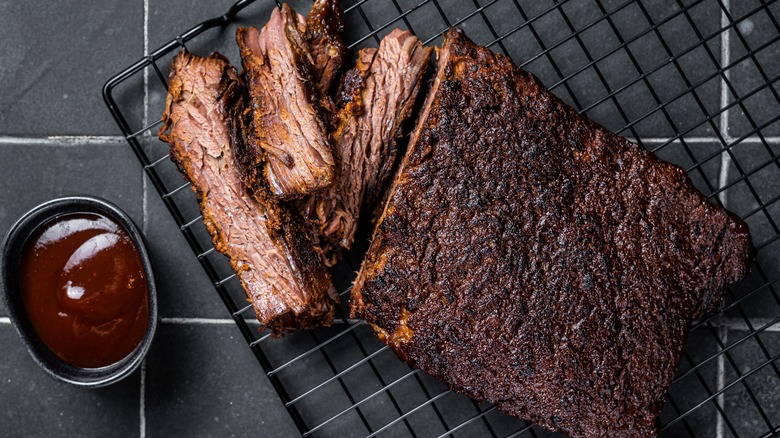How To Trim Your Brisket According To A Pro
Brisket is a large, boneless cut of beef that comes from the cow's lower chest. As a central muscle that supports the weight of the cow, it is a tough piece of meat with a significant amount of connective tissue. Because it's a fatty, muscly cut, it should be trimmed (the excess fat cut off) before being slow-cooked or smoked. However, it's important to know the right amount of fat to trim for a tender and juicy beef brisket.
Fat marbling — fat spread evenly throughout the meat — is crucial for tender, juicy, flavorful beef. However, the thick layer of fat found on quality cuts of brisket can get in the way of a tasty, succulent bite. Chowhound spoke with an expert to learn the best way to trim your brisket for the perfect flavor and texture. According to Derek Piva, Executive Chef at The Restaurant at Tu Tu' Tun Lodge, the key is to trim just the right amount of fat without overdoing it. "Trimming a brisket is about balance," he says. "Leave about ¼ inch of fat on the cap to help baste the meat as it cooks, but trim away any hard fat, as it won't render down." Piva also suggests smoothing out extra-thick or uneven sections of fat so the brisket can cook uniformly. If you do end up trimming too much fat off your brisket, Piva has a simple fix to ensure the meat won't dry out.
What to do if you trim too much fat
The fat cap is the side of the brisket that is completely covered in fat. This layer of fat, typically about 1 inch thick, should be reduced to improve the texture but not totally removed. It's possible to get carried away while trimming, but luckily it's fairly easy to reverse the problem of removing too much fat. Executive Chef Derek Piva advises, "If you accidentally trim off too much fat, brush the brisket with melted beef tallow or a high-quality fat before cooking to help maintain moisture."
Melted beef tallow is beef fat that has been heated until it's liquified, then cooled to solidify it. It also has a high smoke point, making it ideal for smoking brisket. Brisket fat is ideal for rendering beef tallow. If you don't have any beef tallow on hand, you can render some from the fat trimmings from your beef brisket, however the process takes a few hours since you have to heat it low and slow to prevent burning.
Besides tallow, butter can be used to replace some of the fat on the brisket and is something you're likely to have on hand. Butter adds flavor to your brisket while keeping it moist. Melted butter can be sprayed on the beef as it cooks to prevent it from drying out. Other spritzes that can be used during the cooking process to keep your brisket moist include apple cider vinegar, apple juice, beer, and beef broth.

